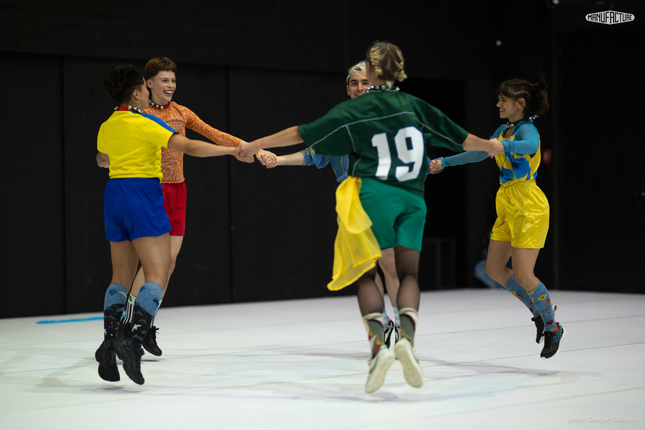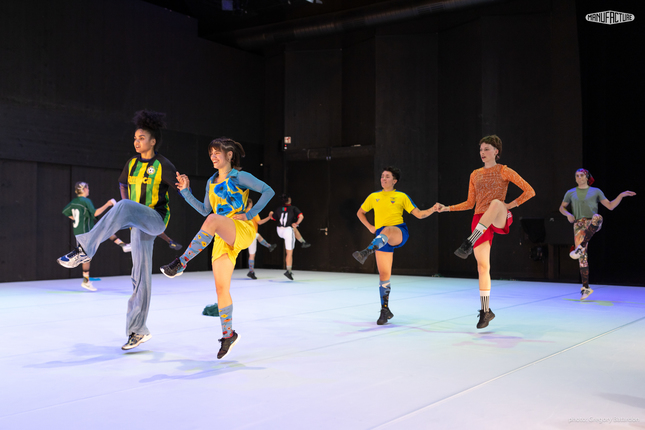
Performance
-
05.07.24
| 01.05.24 - 05.07.24 | On tour |
| BAD |
BA-Dance · Class G : Graduation show - Y. Hugonnet & R. Mriziga
The students of class G present their graduation show, a program in two parts, each composed of an original creation of 30 to 40 minutes.
This year, choreographers Yasmine Hugonnet and Radouan Mriziga will be accompanying the dancers of class G for this graduation show, which brings the Bachelor's degree in Contemporary Dance to a close.
The process for the graduation show includes a period of creation during the academic year with the guest choreographers, followed by a period of residency in a professional venue where the show premieres, and concludes with a tour of several venues in Switzerland and abroad.
Tour
fabrik Potsdam, Potsdam (DE), as part of the festival Potsdamer Tanztage
Wed 22 - Thu 23 May 2024
Théâtre Vidy-Lausanne
Fri 7 – Sat 8 June 2024
Usine à Gaz, Nyon
Thu 13 June 2024
Pavillon de l'ADC, Genève
Thu 20 & Sat 22 June 2024
Belluard Bollwerk Festival, Fribourg
Sun 30 June 2024
Tanzhaus, Zurich
Thu 4 – Fri 5 July 2024
Credits
Choreographers
Yasmine Hugonnet, Radouan Mriziga
Assistants choreographers
Krisztina Abrànyi
Bilal El Had
With the dancers of class G Sira Aymerich i Besalú, isam // Isabela Del Carmen Abad Montalvo, Alice Gratet, Baptiste Homère, Cyan Huescar, Gaëlle Jeanbourquin, Annaïk Juan-Torres, Paula Ramis Muñoz, Nyala Simpson, Jasmin Sisti, Adina Voldrabova, Judit Waeterschoot
Lighting and technical direction
Nicolas Berseth
Sound and video
Zineb Rostom
Thanks
Florine Bugnon and Robert Avery from la Farandole de Courtepin
Durée : 90 min +/- avec entracte
Dès 14 ans
Production
La Manufacture – Haute école des arts de la scène
With the support of Domaine Musique et Arts de la scène HES-SO
Biography
Yasmine Hugonnet
was born in Montreux in 1979 and divides her time between Lausanne and Paris. She spent part of her childhood - from the age of three to six - in Mali. On her return to Switzerland, she took ballet classes and, as a teenager, moved to Paris to study contemporary dance at the Conservatoire National Supérieur de Musique et de Danse. Her interests include contact improvisation, butō and composition. From 2003 to 2004, as part of the "Dance Unlimited" master's program in choreography in the Netherlands, she explored the notion of presence. In 2009, she founded her group Arts Mouvementés and created several solo shows, including "Le Récital des postures", which won the 2017 Swiss Dance Prize in the "current dance creation" category. Since 2018, her works have been co-produced by the Théâtre de Vidy. Yasmine Hugonnet/Arts mouvementés currently benefits from a three-year contract with the city of Lausanne and the canton of Vaud.
Radouan Mriziga
is a dancer and choreographer from Brussels, originally from Marrakech, where he began his dance training, continuing in Tunisia and France before graduating from P.A.R.T.S in Brussels. In 2013, he began his research as artist-in-residence at Moussem Centre nomade des arts (Belgium). There he worked on his first solo 55, followed by a group choreography 3600 in 2016, and in 2017 by 7, the third part of the trilogy. Produced by Moussem, this trilogy explores the relationship between choreography, construction, Islamic art, craft and architecture, and depicts human beings as an act of balance between intellect, body and spirit. From 2017 to 2021, Radouan Mriziga is in residence at the Kaaitheater in Brussels.
Note on intention
Yasmine Hugonnet
Empathic chamber
From copying to empathy, what are the movements?
Is this what we're all about? The piece plays with desires for "commonality", in language, in space. It wants to share the inventiveness and beauty of the state we find ourselves in, when we're learning, or in a process of appropriation. It is, for example, a composition of two distinct presences: one person who plunges into the adventure of gesture to generate movement, i.e. a "source" person. And another person, an empathetic "double" who can move along the whole creative scale that exists between non-participating observation and formal, totally faithful imitation of the "source's" language. What do I recognize, what do I want to make my own? The aim is to explore the issues involved in appropriating another's language through affective and mimetic empathy. Sensing the emerging gesture, pursuing it, deducing it, preceding it, inducing it.... The performance draws on the tools developed as part of my ongoing research into the concomitance of immobility and movement, attention and the practice of reciprocity. I will be part of a series of works on empathy.
Radouan Mriziga
Al-Monboso
In our modern era, there is a growing tendency to view wild landscapes, such as mountains, forests, oceans, and deserts, merely as sources of capital. However, for centuries, these landscapes served as both refuge and endless inspiration for the arts, philosophy, and science.
By observing and learning from communities that have maintained a close relationship with these environments, and have developed knowledge through spirituality, art, philosophy, craftsmanship, and science, we aim to approach these natural settings with the perspective of those who still regard them as fountains of knowledge and artistic inspiration.
Our journey will focus specifically on mountains, exploring how they symbolize both romantic and political spaces. For instance, we will delve into the significant role mountains have played throughout art history, how they continue to serve as sources of spirituality and inspiration for many artists (as seen in romantic art, for example), as well as places for reflection and contemplation within various religious traditions.
Mountains also have a political dimension, offering refuge and natural protection during times of conflict and oppression, and acting as resistance strongholds for communities challenging city authorities.
Beginning with dances, mythologies, stories, poems, music, paintings, songs, and rhythms originating in or inspired by these landscapes, we will collaboratively create choreographies. These choreographies aim to contribute artistically to the ongoing discussions surrounding the hierarchy of knowledge, the sharing of knowledge, and the current relationship between art and our ecological environments.
Events
 11.02.26
11.02.26
-
12.02.2611.02 - 12.02.2026
BA-Dance · Class H : Bachelor projects' presentations
The 3rd year students of the Bachelor in Contemporary Dance invite you to discover their end of studies projects.
 31.03.26
31.03.26
-
01.04.2631.03 - 01.04.2026
BA-Dance · Class I : 2nd year creation
The students of the Bachelor in Contemporary Dance class I invite you to discover their 2nd year of studies creations at La Manufacture.
 07.05.26
07.05.2607.05.2026
BA-Théâtre · Promo P : Présentation de fin d'atelier avec Jean-Yves Ruf
The 2nd year students invite you to discover the results of their artistic exploration with director Jean-Yves Ruf.
 11.05.26
11.05.26
-
12.05.2611.05 - 12.05.2026
BA-Danse · Class H : Presentation of the Collective Projects
The 2nd year students of the Bachelor in Contemporary Dance - class I invite you to discover their creations, developed in small groups.












